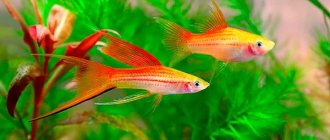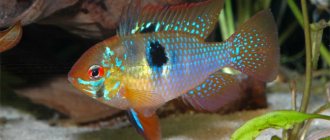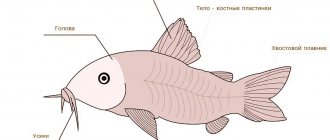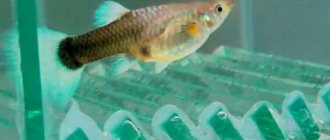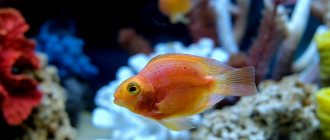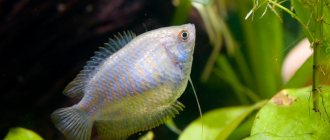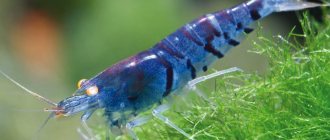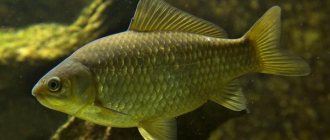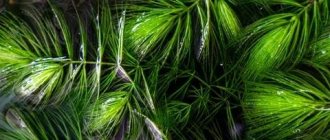What to feed and how, what food is the best?
Swordtails are very unpretentious to food; they willingly feast on live, frozen food, dry flakes and granules. Fish take food in all layers of water and can even pick it up from the ground, but mostly they still feed near the surface.
The diet should be varied, it is especially important to include plant components, since in natural conditions Swordtails primarily feed on algae.
The fish should be fed 1-2 times a day; the portion should be eaten almost immediately. Swordtails are prone to overeating, so once a month you can have a fasting day and not give them food.
A notable feature of this species is the ability to live for a long time without food. Fish can fast for up to 2 weeks without any harm to health, which will especially appeal to owners who are often forced to leave home. However, if you leave the fish alone for a long time, then make sure to place plants and small snails in the aquarium, which will become a valuable source of nutrients.
Requirements for an aquarium
Swordtails feel comfortable in an aquarium of any shape, the main thing is to provide free space for swimming, as they love to have active games.
The aquarium must be covered with glass or a lid so that pets cannot jump out.
Water temperature and other characteristics
The fish are very unpretentious to water; they are usually satisfied with average values:
- temperature – from 20 to 28°C (optimally – 23-25 degrees);
- acidity – 7-8 pH;
- hardness – 9-10°gh.
Weekly water changes are about 20% of the volume, but Swordtails usually do not like fresh water.
Try changing the water once every 2 weeks, while carefully monitoring the condition of the fish: if they behave playfully and actively, then such conditions suit them.
Optimal volume of water for comfortable living
Swordtails need quite a lot of space - for example, one individual can be kept in a container of at least 35 liters. As the school increases, the volume of water increases; usually, a group of fish consisting of 1 male and 2-3 females requires about 50 liters. They feel uncomfortable in a small aquarium; if you purchased young specimens, they simply will not grow in a limited space.
Plants
In nature, these fish settle in dense thickets of vegetation, which serve them as food and protection from enemies, so the aquarium should also have a lot of algae. Usually the following is placed in the container:
- Vallisneria;
- Echidonorus;
- cryptocorynes.
In this case, islands of plants should be combined with wide space for swimming.
Priming
Swordtails are indifferent to the soil, so you can take any substrate.
It is advisable that it be dark, since the fish look more impressive against such a background. Several shelters and natural driftwood should be placed at the bottom so that weak individuals can hide from aggressors. In addition, single-celled algae develop on snags, which serve as good food.
Necessary equipment
An aquarium cannot do without a filter and a compressor.
You need to install a heater in the aquarium, as Swordtails are sensitive to temperature changes.
It will come in handy, for example, in the off-season, when the heating in the house is turned off, but it’s cold outside.
Lighting
These fish do not like too bright light, so the aquarium should be installed away from indoor lamps and direct sunlight. The lighting should be diffused and subdued; for greater effect, you can use plants with wide leaves or floating algae.
Swordtails - reproduction
Reproduction of aquarium swordtail fish
What to do if swordtail breeding occurs in a community aquarium?
In this case, first of all, the fry must be immediately carefully removed using a net with a small cell and moved to a separate reservoir.
Many wildlife lovers. If this is not done, then the babies can become food for other inhabitants of the aquarium. They wonder how swordtail fish reproduce in a common aquarium, because here newborn babies are exposed to serious danger. In this case, you simply need to place plants in the reservoir that form dense thickets in which the fry could easily hide from predators. These can be cabomba, elodea, vallisneria, etc. seaweed. At the same time, green thickets should alternate with free space so that the rest of the fish have enough free space to swim.
The most interesting fact about the reproduction of swordtails is that they are able to interbreed with each other, regardless of the species, thereby generating new populations of unique fish. Therefore, who knows, maybe you will be lucky enough to become the owner of a unique and amazing species of swordtails.
WomanAdvice.ru>
Check-in rules
Swordtails have a reputation for being pugnacious fish, while many aquarists consider them to be very peaceful. The fact is that these fish have a strong hierarchy and very powerful males.
It is optimal to keep 1 male and a group of females in the aquarium. If there are equal numbers of “girls” and “boys,” then the females will constantly suffer from attacks and persecution. Moreover, males always chase each other fiercely, so in any case it is better not to keep several “boys”.
Read about how to distinguish a female from a male here.
Who do you get along with best?
As noted above, Swordtails behave peacefully if there are no aggressors in the flock. When the ratio of males and females is correct, they do not pay attention to other fish.
Compatibility table for Sword bearers
Thus, all proportionate peaceful species will become good neighbors:
- Danio;
- Ternetia;
- Pecilia;
- Angelfish;
- Barbs;
- Minors;
- Gourami;
- catfish (Coridoras, Ancistrus).
You should not add large cichlids (for example, Astronotus), as they will terrorize the fish.
In turn, species with long veil fins (Cockerels, Goldfish) will experience the unhealthy attention of Swordtails.
This issue is discussed in more detail in an interesting article about the compatibility of swordtails with other fish.
Compatibility among “friends”
Some sources report that different breeds should not be kept together. Others, on the contrary, do not prohibit doing this and even recommend crossing varieties to obtain fish with an unusual appearance. As in previous cases, it is necessary to monitor the total number of males - they behave peacefully only if there are much more females.
Male above, female below
In addition, some species do not get along in the same aquarium due to different body lengths and shapes, as well as character traits. Thus, the Black Swordtail does not tolerate an overcrowded aquarium and conflicts with the Santa Claus breed (Kohaku), although both species grow up to 10 cm.
Species that are too small will inevitably suffer from the aggression of large fish. For example, you should not keep Pygmies, which reach only 3-4 cm, and the Pineapple Swordtail (body length up to 10 cm) together.
How to care for swordtail fish :: aquarium swordtail fish :: Aquarium fish
How to care for swordtail fish
The aquarium fish swordtail belongs to the order of carp-toothed fish, the family of platycilids. In nature, such fish can be found in the reservoirs of Guatemala, Central America, Mexico and Honduras. Before you acquire swordtails for your aquarium, you need to familiarize yourself with the rules of their maintenance and nutrition.
Question: “Opened a pet store. Business is not going well. What to do? » — 2 answers
Description of swordtails
The body length of males reaches 8 centimeters, females - 12 centimeters, it all depends on the conditions of keeping swordtails. A characteristic feature of swordtails is a peculiar process on the lower part of the caudal fin, which resembles a sword in appearance. Often there are hybrids with a pair of swords, as well as an enlarged dorsal fin. Females have a less bright color. The anal fin of the male is transformed into a gonopodium - a sexual organ intended for reproduction. Swordtails are peaceful towards other fish species and get along well with them in the same aquarium. There should be more female swordtails than males. A strong male often pursues a weaker one.
Contents of swordtails
Swordtails are not picky about living conditions. The most optimal water temperature in the aquarium is 24-26 degrees. The fish easily tolerates a temporary drop in water temperature to 16 degrees. Hardness can vary over a wide range - 8-25 dH, but acidity is recommended to be maintained within 7-8 pH. At least once a week, replace one third of the volume of water in the aquarium; it is advisable to periodically enrich the water with oxygen.
Plant the aquarium with small-leaved plants that form dense thickets (Toothed Elodea, Cabomba or Vallisneria). The fry will be able to hide in them from adult fish. Throw lacy green moss – riccia – over the surface of the water, which forms picturesque islands. Swordtails are very active fish, they sometimes frolic so much that they can jump out of the aquarium. To avoid this, cover the aquarium with a lid.
Feeding
The life activity of swordtails, however, like other species of fish, depends on proper and nutritious nutrition. They are absolutely unpretentious in food. The optimal diet should include plant and live food: tubifex, brine shrimp, daphnia, spinach, algae, various varieties of lettuce, bloodworms, cyclops, mosquito larvae, crushed oatmeal, peas and nettles. You can use any food, live or canned, dry or frozen. If you need to go on vacation or a business trip, there is no need to worry, since aquarium swordtails can easily tolerate a lack of food for one to two weeks without harming their health. Fish feed on various algal foulings that form on aquarium glass or plant leaves.
Reproduction
Swordtails belong to the group of viviparous fish; they give birth to fully formed and large fry. Gestation lasts about forty days; before giving birth, the female’s abdomen enlarges and takes on a square shape. Place the female in a separate container with plenty of small-leaved plants. After giving birth, return her back to the community aquarium. Starter food for fry: brine shrimp, nematodes, chopped tubifex, chicken egg yolk, industrial feed.
Video on the topic
KakProsto.ru>
Reproduction at home
Swordtails are viviparous fish that reproduce easily in an aquarium. Under suitable conditions, they can produce offspring every 3-4 months.
In warm, oxygen-rich water, the male fertilizes the eggs, which are carried by the female until they develop into full-fledged fry.
Pregnancy for females usually takes 30-40 days.
Pregnant female Swordtail
Spawning should be carried out in a separate aquarium, where the female gives birth to from 15 to 100 fry.
After giving birth, the adult must be immediately returned to the general aquarium, otherwise she will happily feast on her own offspring.
How to keep fry, as well as the nuances of feeding them
Keeping the fry is a topic for a separate article. If you plan to breed Swordtails at home, then you definitely need to know all the nuances of the process. The issue of keeping fry is discussed in more detail in this article.
The fry that are born are large enough to eat nutritious food. Several times a day, in small portions, they are given “live dust” , crushed tubifex and brine shrimp, and you can also use special dry food.
Aquarium swordtail fish: reproduction and maintenance
Swordtails - aquarium fish: types
Fish aquarium
Swordtails do not require any careful care. This makes them easy to maintain. They do not need a special composition or a certain amount of water; they can withstand low temperatures quite well (the optimal water temperature for them is 23-25°C). Water hardness also does not become a problem for these fish - 8-25. Acidity is acceptable within 7-8.
To set up an aquarium, you first need to figure out what shape it will be. It is better to take a rectangular aquarium without any decorative decorations that will only get in the way.
As for volume, for two representatives of this species or fish of similar size, an average of 8-10 liters of water is required, that is, 10-15 individuals per 50 liter container.
The aquarium should be installed closer to the window, because both the fish themselves and the plants need light. But putting it on the windowsill is a bad idea, since the sun or the heat of the radiator will overheat the water and it will bloom.
The surface must be flat, otherwise the walls of the aquarium may burst (if this happens, then the article “Repairing an aquarium at home” will help correct the situation).
It’s better when there are plants in the container, then you don’t have to be afraid to leave your pets without food in rare cases. Aquarium plants should be chosen as densely as possible so that the fry can hide from older individuals. But there should also be space for the fish to move freely. Riccia, glitter and cabomba are suitable for this.
At least once a week it is recommended to replace 20-30% of the aquarium water with clean water, and you can also add sea salt to it.
You can use regular pebbles as soil for an aquarium. Aeration of water is desirable, but not necessary if the population density of fish is low.
As for food, swordtails are universal here too - any food will suit them, both live and dry. It is recommended not to forget about plant foods and use them in addition to algae. Varieties of lettuce, spinach or oatmeal are suitable for this.
When deciding to have these fish, you need to remember the so-called hierarchy, and therefore it is better to place more females in one aquarium. A few males are enough, preferably 3-4, so that there is not much competition between them.
The aquarium should always be covered with something on top, since swordtails are very nimble and love to jump out of it.
Aquarium swordtail fish: compatibility with other species
Reproduction
Diseases
aquariumguide.ru>
Why do they jump out of the aquarium?
Swordtails are known for their love to jump out. There are several different reasons for this behavior:
- during active games during the mating season, the fish jump out of the water;
- when the light changes abruptly (turning on or off in the dark), Swordtails get scared;
- when trying to catch insects that are attracted to the surface of the water (for example, mosquitoes);
- when the water in the aquarium is contaminated, because The fish feel very bad in it.
In the latter case, the water should be changed and its parameters should be constantly monitored in the future. All other situations are considered normal behavior for these fish, so the owner just needs to protect the aquarium with a cover glass or lid.
Price
The price of representatives of the black morph varies depending on the size and age of the fish, as well as its origin. On average, the cost of fry is 50-100 rubles, teenagers - 100-200 rubles, adult fish - 200-400 rubles. Fish of unknown origin or obtained as a result of random crossing of representatives of different morphs will cost less than linear individuals bred as a result of targeted selection.
The black swordtail is a spectacular morph that stands out from the background of other inhabitants of the aquarium and attracts the eye of the observer. Fish of this color are easy to keep, unpretentious and suitable for a beginner’s first aquarium. Representatives of this morph are regularly found on sale both in pet stores and in the offers of private breeders. If you liked the article, leave comments and share a link to it on social networks.
Why don't they grow?
Many aquarists purchase juveniles that subsequently do not grow at all. There are several factors that negatively affect the development of fish:
- small volume of the aquarium (it should be at least 35 liters for one individual);
- poor care, infrequent water changes, which results in the formation of a lot of ammonia;
- The diet does not include plant foods.
Such situations should be corrected immediately. If a little time has passed, then Swordtails can still grow, sometimes they remain small.
Description
The body size and shape of the fins in fish of this morph do not differ from those of standard representatives of the species. The main difference is the color.
The coloring of these fish is original and memorable. The body is painted in a rich black color, which under certain lighting casts blue-green. Individual silver-white or red-orange scales are scattered over the entire surface of the body; It is possible for one individual to have inclusions of both colors. The iris of the eyes is also painted silver-white, making the eyes stand out clearly against the general dark background. The fins are transparent, red-orange or whitish in color.
